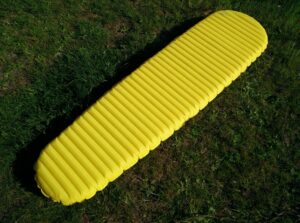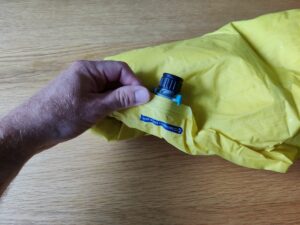If you’re new to backpacking, you might find yourself in a dilemma whether to buy an inflatable sleeping pad or a closed-cell foam model. Both options have advantages and disadvantages. Therefore, it’s crucial that you understand the key differences between both product types before making the purchase. Here we’ll delve into the comparison of inflatable and foam sleeping pads, examining various aspects such as comfort, warmth, weight, packability, reliability, ease of use and price. The information below will provide you with valuable insights and help you make an informed choice for a good night’s sleep in the great outdoors.
Table of Contents:
- Comfort and Warmth
- Weight and Packed Size
- Ease of Use and Setup
- Reliability and Lifespan
- Price
- Conclusion
Comfort and Warmth

Comfort-wise inflatable sleeping pads are a clear winner. They’re also warmer and thus suitable for winter, depending on the model.
A good sleeping pad makes your nights in the great outdoors comfortable and warm. Inflatable sleeping pads provide excellent cushioning since they feature air chambers that conform to the contours of your body. Furthermore, they enable you to adjust firmness according to your preferences. Closed-cell foam sleeping pads are harder and most people find them less comfortable than inflatable sleeping pads, the exception being those who prefer sleeping on relatively hard surfaces.
Now in terms of warmth, the inflatable sleeping pads are also a clear winner. Air is a good insulator because it’s a gaseous substance and thus a poor conductor of heat and cold. Closed-cell foam sleeping pads also feature tiny air pockets to prevent conductive heat loss, but obviously there is less air in closed-cell foam sleeping pads than in inflatable sleeping pads.
The warmth of a sleeping pad is measured with R-value. The higher the R-value, the warmer is the sleeping pad. Inflatable sleeping pads typically have R-values between 2 and 8. Foam sleeping pads have R-values from 1 to 2. Foam sleeping pads are thus only suitable for summer and warm nights in spring and fall. Inflatable sleeping pads are also great for winter, depending on the R-value. For cold winter nights R value of 5 or more is required.
Weight and Packed Size
Closed-cell foam sleeping pads are usually lighter than inflatable sleeping pads. However, some top-notch inflatable sleeping pads are also super lightweight. For example, the Therma-a-rest NeoAir UberLite inflatable sleeping pad weighs only 8.8 oz. (250 g) which is less than most foam sleeping pads. Nevertheless, the UberLite sleeping pad is indeed an exception among inflatable sleeping pads. Inflatable sleeping pads typically weigh more than 1 lb. 2 oz (500 g) while closed-cell foam sleeping pads weight around 14 oz. (400 g).
Inflatable sleeping pads pack smaller than foam sleeping pads. A high-quality foam sleeping pad will measure around 20 x 5 x 5 inches (50 cm x 13 cm x 13 cm) while a top-notch inflatable model will measure around 9 x 4.1 inches (23 cm x 10 cm). Therefore, foam sleeping pads are usually attached to the backpack with straps while inflatable sleeping pads are typically carried in the backpack. This is important if you’re planning to carry the sleeping pad on an airplane at some point. An inflatable model will be much easier to pack. So, in terms of packability, inflatable sleeping pads are a clear winner.
Ease of Use and Setup
High-quality inflatable sleeping pads are generally straight forward to set up. Most models come with an integrated inflation system. Some can be inflated by blowing air into a valve and others have self-inflating system. This feature eliminates the need for manual inflation and simplifies the setup process. Nevertheless, it also introduces an extra component that can fail and increases the price and the weight of the products.
Foam sleeping pads are easier to set up. You simply unroll it and that’s pretty much it. Packing an inflatable sleeping bag also requires more work than packing a foam sleeping pad. You must first get all the air out of it so you can pack it into a stuff sack. All in all, a foam sleeping pad is just easier to use.
Reliability and Lifespan

Inflatable sleeping pads have shorter lifespan. Nevertheless, most inflatable sleeping pads come with repair kits
Closed-cell foam sleeping pads are known for being durable and reliable. They’re made of dense foam materials and thus resistant to abrasion. On a foam sleeping pad there is basically nothing that could fail. A foam sleeping pad can last for 20 years and more.
That’s not the case with inflatable sleeping pads. Inflatable sleeping pads have valves that can fail, and the body can get punctured on rough terrain. Nevertheless, inflatable sleeping pads do usually come with a repair kit which enables you to patch it up on the go. So, if you take care of your inflatable sleeping pad it can last for more than 10 years.
Price
A good inflatable sleeping pad will cost you more than $150. Inflatable sleeping pads feature many expensive components (material, valve etc.) and thus the prices are relatively high. On the other hand, foam sleeping pads are very inexpensive. You can get a somewhat decent foam sleeping pad for $25. Nevertheless, a high-quality foam sleeping pad will cost you from $40 to $60. Still, the price difference is indeed quite big.
Conclusion
So, should you buy an inflatable sleeping pad or a closed-cell foam sleeping pad? Well, that depends on many factors and of course also your personal preferences. If you’re planning to use the sleeping pad in winter, then you should obviously go for an inflatable model because a foam model will not provide sufficient warmth. If you mostly do trips in summer and are tight on budget, go for a foam sleeping pad. Foam sleeping pads are cheaper and provide sufficient warmth in summer, early fall and late spring. Consider also what’s important to you in terms of comfort, packability, reliability and ease of use. Inflatable sleeping pads are more comfortable and pack smaller. Foam sleeping pads, on the other hand, excel in reliability and are very easy to use.
I’d love to hear about your thoughts on inflatable and closed-cell foam sleeping pads. Write them in the comments section below.























